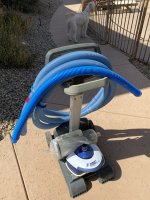kdahlgren249
Active member
Looking at a refurbished model on poolpartz Dolphin Nautilus CC. Want to keep costs down and knock out just what I need to get rid of my archaic polaris pressure side. has necessary is adding an 'ultra fine' basket on a nautilus CC?
oh and other question, I'm seeing some review that this model won't go up walls very far, we have the diagonal floors in the deep end with only a small flat spot in the middle of it, and then flat ramp up to a flat shallow end. Would this have trouble getting most of my deep end or does it only struggle with true verticals? May be worth the extra money to get something that climbs walls for waterline to ensure it's getting up all the walls where I see algae growths periodically. Debating if I upgrade to a Triton or Explorer for $750 on there to get it up the walls.
My pool layout basically is this, but the diagonals from the deep end are about 45 degrees to get about halfway up then straight vertical to the ground.

oh and other question, I'm seeing some review that this model won't go up walls very far, we have the diagonal floors in the deep end with only a small flat spot in the middle of it, and then flat ramp up to a flat shallow end. Would this have trouble getting most of my deep end or does it only struggle with true verticals? May be worth the extra money to get something that climbs walls for waterline to ensure it's getting up all the walls where I see algae growths periodically. Debating if I upgrade to a Triton or Explorer for $750 on there to get it up the walls.
My pool layout basically is this, but the diagonals from the deep end are about 45 degrees to get about halfway up then straight vertical to the ground.





